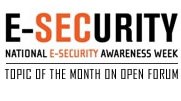A shift in thinking

While we all have our own safety guidance, coming together to consolidate these messages and working across sectors is critical to making impact with consumers.
What’s the first thing you do when you leave you house? If you’re like me, and most people I assume you check that you’ve got your keys and turn around and lock the door. It’s such a simple, and probably entirely automatic act, but it’s a crucial step in protecting your home and family from invasion and theft.
But what do you do when you get up and leave your computer? Do you have a lock in place, do you have protection against viruses, and do you let people you don’t know into your life, sharing with them private information? What we’re essentially talking about is “physical security” and therefore we must secure our computers with technology in the same way we secure the doors to our homes.
And while people tend to use the terms “computer security” and “online safety” interchangeably, online safety really refers to the range of Internet behaviours that need to be employed to keep you, your family and your personal information safe from exploitation.
The problem is that at the moment many Australians are effectively leaving their computer doors unlocked, and windows open. Likewise, they may be engaging in risky Internet behaviours by telling complete strangers where their kids go to school, and sharing their credit card details without even realising.
Which is why National E-security Awareness Week is so important. T his is the second year Microsoft has actively participated in this event, and while our core messages largely remain the same, the threats continue to evolve and therefore the basic safety and security guidance needs to be continually reinforced.
his is the second year Microsoft has actively participated in this event, and while our core messages largely remain the same, the threats continue to evolve and therefore the basic safety and security guidance needs to be continually reinforced.
There are three basic pillars to internet safety and security:
- “Protecting Your PC“, by updating your anti-virus and anti-spyware software, turning-on your firewall, and turning on your automatic updates;
- “Protecting Yourself“, by using strong passwords, being careful about what you download and what attachments you open, by managing your personal information carefully and reporting any problems you encounter, and finally;
- “Protecting Your Family“, by talking to your kids about what they do online and encouraging them to communicate with you if they encounter anything that makes them uncomfortable or feel threatened. Good communication with your kids can be supplemented by clear family rules for Internet use and the deployment of family safety software. This is especially important given the internet tools that kids are now so comfortable with using such as chat rooms, email, instant messaging, texting on their mobile phones as well as social networking sites like facebook and myspace.
When it comes to sharing information on the internet we need to be as careful as we are in real life. Just as you would not walk alone through a dark alley at night or give a stranger on the street your credit card details, many people would be surprised how much information can be found about them online, to the point where someone else could adopt their identity, and use it to defraud them of money or commit other crimes.
Adults need to be aware of these risks, and share that concern with their kids, because we’re also seeing an increase in cyberbullying and unfortunately even online predation to which unsupervised teens, prone to taking risks, are particularly vulnerable.
The basic message is the whole is greater than the sum of the parts. National E-security Awareness Week is truly a partnership between the Australian Government, industry, law enforcement and the NGO community. And, while we all have our own safety guidance, coming together to consolidate these messages and working across sectors is critical to making impact with consumers. When it comes to protecting yourself and your family online there are some simple steps anyone can follow which will make a big difference to the level of risk you face, and ensure you and your kids can enjoy the internet as a social and intellectual resource.
So check out the resources that are available online, and take this opportunity to ask what you need to know. Two sites that provide comprehensive information for Australian consumers include www.staysmartonline.gov.au and www.microsoft.com.au/protect. These sites should go a long way in helping computer users identify some of the things they need to do to have a safer and more enjoyable online experience. Because taking the measures you need to to keep safe online should be as automatic, and as easy as locking your door, and closing your windows.
________________________________________________
Visit www.StaySmartOnline.gov.au for details and step by step information on e-security.
Julie Inman – Grant is the Australian eSafety Commissioner. She has more than 25 years of experience in the corporate, government and non-profit sectors, working at the intersection of technology, public policy and online safety.











